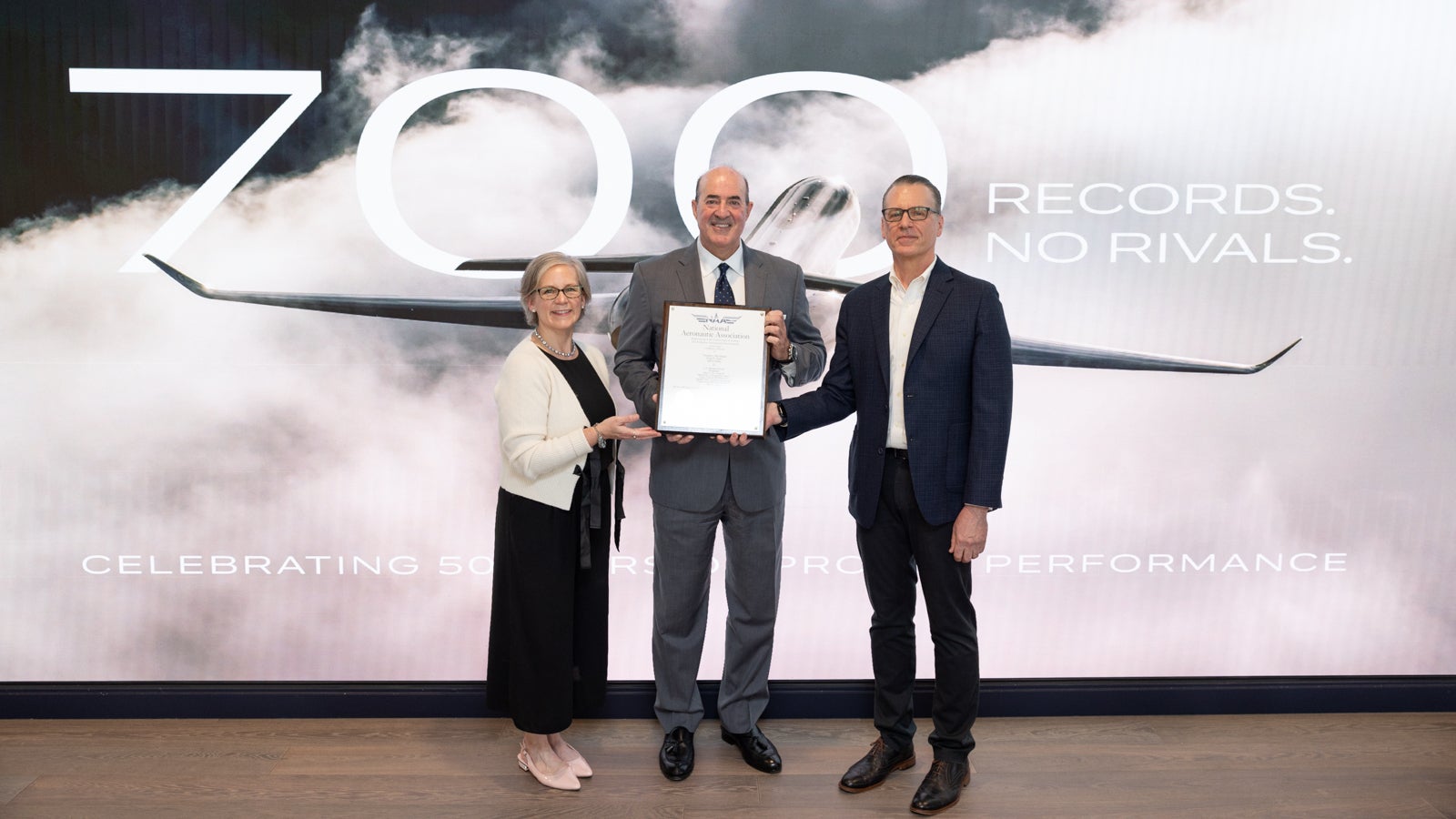NEW YORK—Though it was achieved on April Fool’s Day, Gulfstream’s 700th city-pair speed record is no joke.
The ultra-long-range business jet manufacturer on Tuesday revealed that its flagship G700 flew 14 hours and 38 minutes from Taipei, Taiwan, to Miami, achieving a ground speed of 590 mph (513 knots) and cruising at Mach 0.87 on average during the approximately 7,700 nm trip. The aircraft is designed for a top speed of Mach 0.935, typically cruising at Mach 0.85.
The feat comes half a century after the National Aeronautic Association (NAA) accredited Gulfstream’s first speed record, a 1975 GII flight from St. John’s, Antigua, to Dakar, Senegal. According to Mark Burns, president of Gulfstream, the achievement is an example of the manufacturer putting its money where its mouth is.
“That’s why we do the speed records—it’s really to verify the performance of these airplanes,” Burns told FLYING at a media event in New York City, where the NAA awarded a certificate to test pilots Timothy McClelland, Dany Daher, and Jeff Kelley. “It’s not just us putting out marketing or advertising that something happened, but a third party verifying that the performance is really there.”
Art Greenfield, senior vice president of contests and records for NAA, said that in order to achieve a speed record, an aircraft must demonstrate at least a one percent improvement in performance. To verify it, an FAA dispatcher analyzes timestamps collected when weight is placed on or taken off of the aircraft’s wheels. These are then used to calculate average speed.
Gulfstream has racked up plenty of milestones since unveiling the G500 and G600—the first in its current family of business jets—in 2014. The G650, for example, holds the record for the fastest westbound around-the-world trip. The G650ER, which flies about 500 nm farther than its predecessor, achieved the farthest and fastest nonstop business jet flight in history, flying from Singapore to Tucson, Arizona, in 2019. Combined, those two models have compiled 133 speed records.
Already, the larger, faster G700—which was certified and entered service in 2024—has accrued 82 city-pair records, including more than 50 prior to certification. By comparison, rival Bombardier’s Global 7500 has set 100 speed records on its own, the firm reported in March.
But Burns said features like the G700’s Symmetry flight deck and best-in-class cabin altitude of 2,840 feet when flying at 41,000 feet—narrowly besting the Global 8000’s projected cabin altitude of 2,900 feet—set it apart from competitors.
“The speed of the airplane is legit,” said Burns. “We believe it speaks for itself, and we believe that when we’re out competing every day, we can prove the difference.”
Bombardier this month said the Global 8000, with a projected range of 8,000 nm and speed of Mach 0.94, is “on schedule” to enter service this year, pending regulatory approvals. Gulfstream, though, may beat it to the punch after receiving both FAA and European Union Aviation Safety Agency (EASA) certification for its G800 last week. Burns on Tuesday declined to disclose a target for G800 deliveries in 2025. But he said the first customer shipment is expected in the “next few weeks.”
The manufacturer last week also revealed the G800 will have a top speed of Mach 0.935 and 8,200 nm range, both higher than announced when the concept was unveiled in 2021. It will maintain the G700’s cabin altitude.
“The cabin altitude of 2,840 feet is the lowest in the industry, if not in all of aviation,” said Burns. “And I will tell you, as an older passenger, when you fly 10, 12 hours and you get off the airplane, you don’t have jet lag. You don’t feel as fatigued.”
Complicating the firm’s outlook is a cantankerous tariff environment. Burns said Gulfstream is “not troubled” by the fluctuating import and export duties levied by President Donald Trump but is “trying to be educated about what could occur.”
“We are trying to understand what the impacts may be globally,” Burns said. “There’s no doubt aviation is a global marketplace—it’s a global supply chain.”
Burns noted that Gulfstream’s supply chain includes suppliers in West Europe, Mexico, and Asia, where some countries have been hit with staggering tariff rates. As the manufacturer ramps up G700 deliveries and G800 production, it hopes to get more clarity from the White House.
“We want to make sure [the administration] understands the facts as we see it,” he said.
Credit: flyingmag.com











